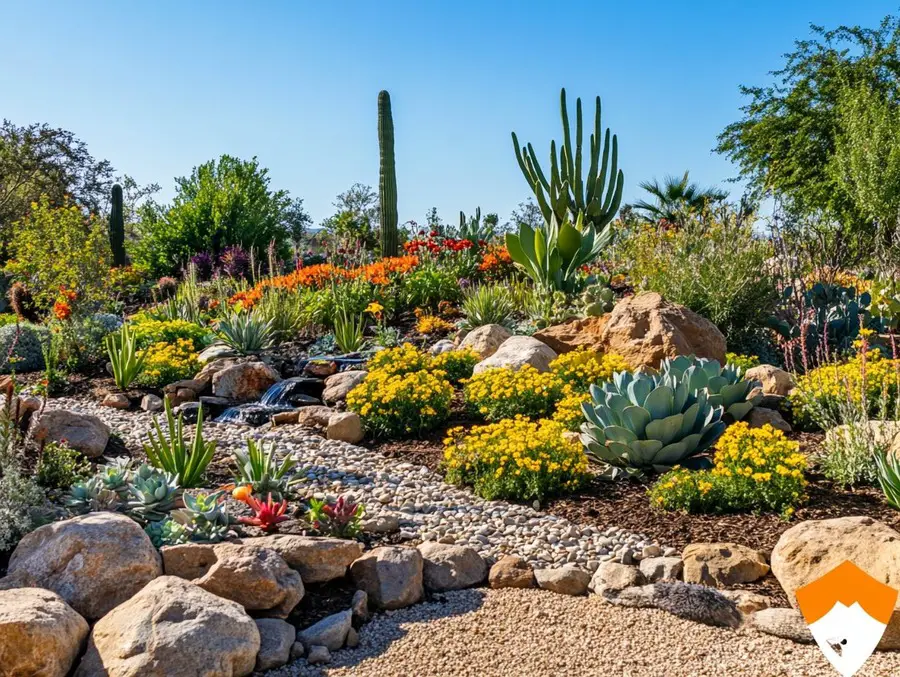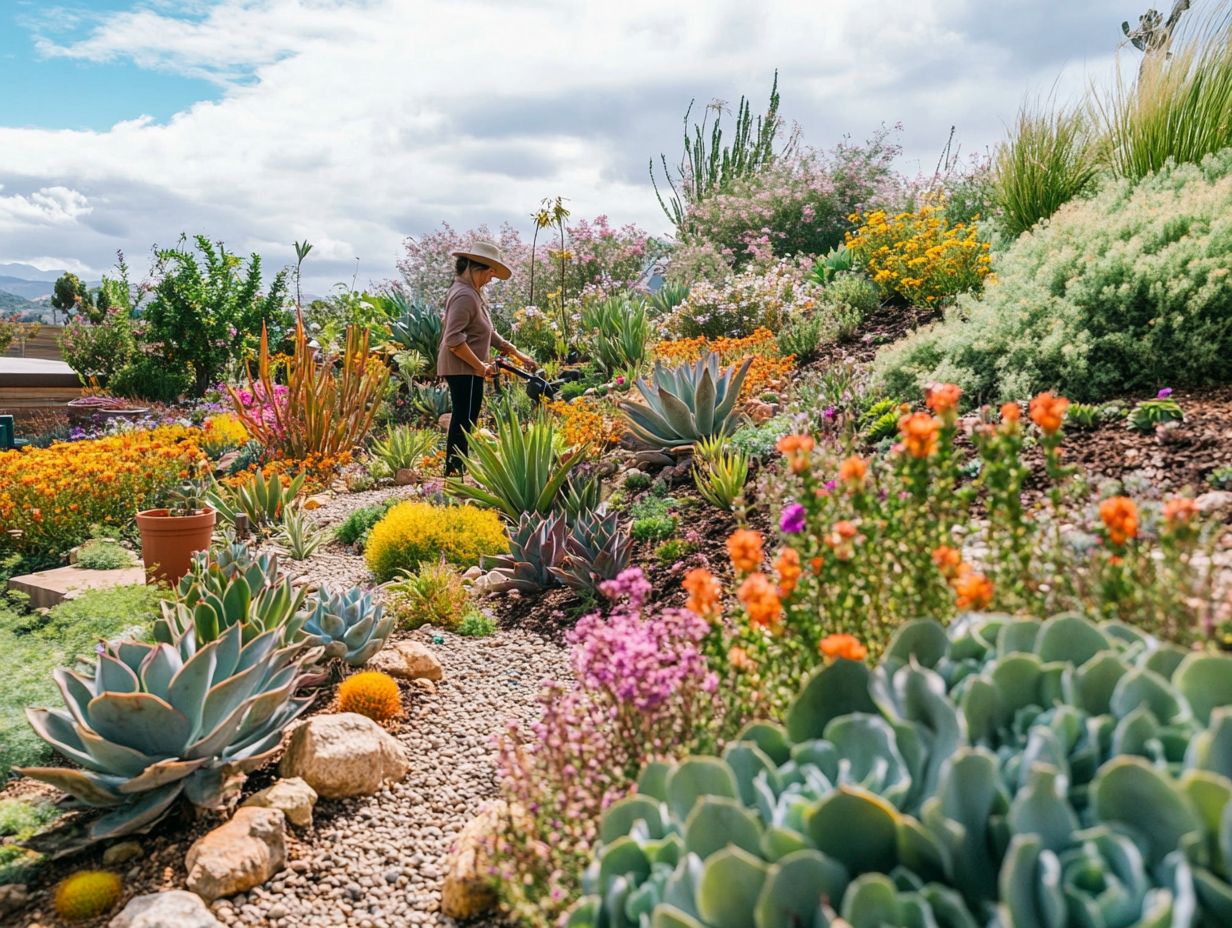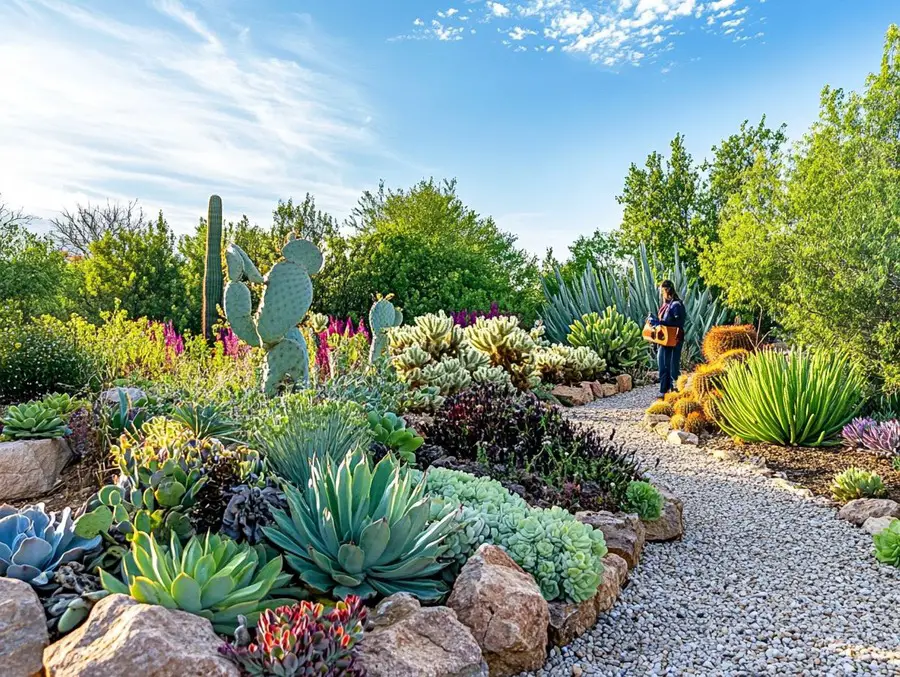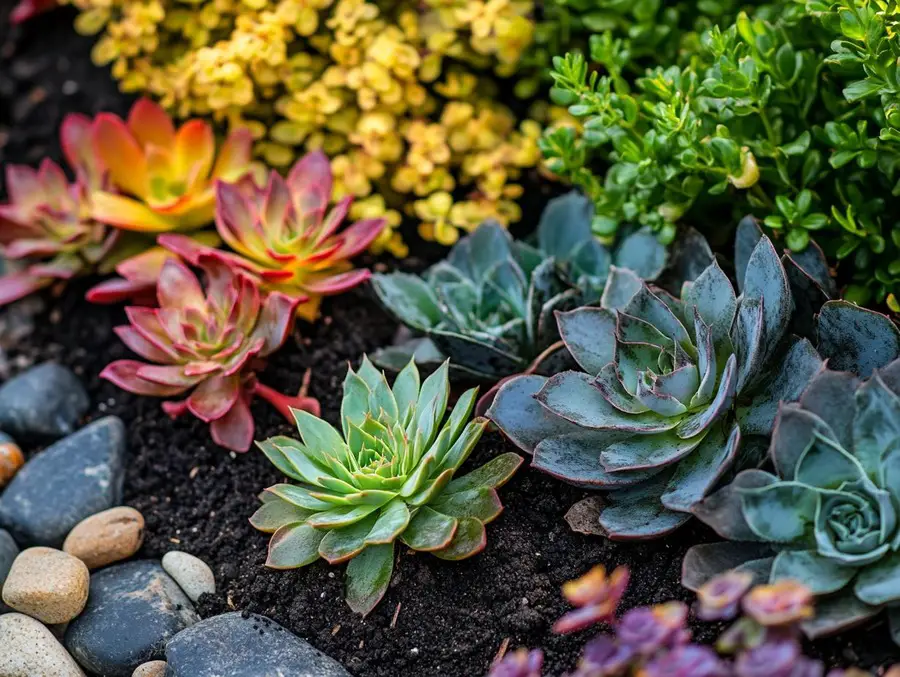We use affiliate links. If you purchase something using one of these links, we may receive compensation or commission.
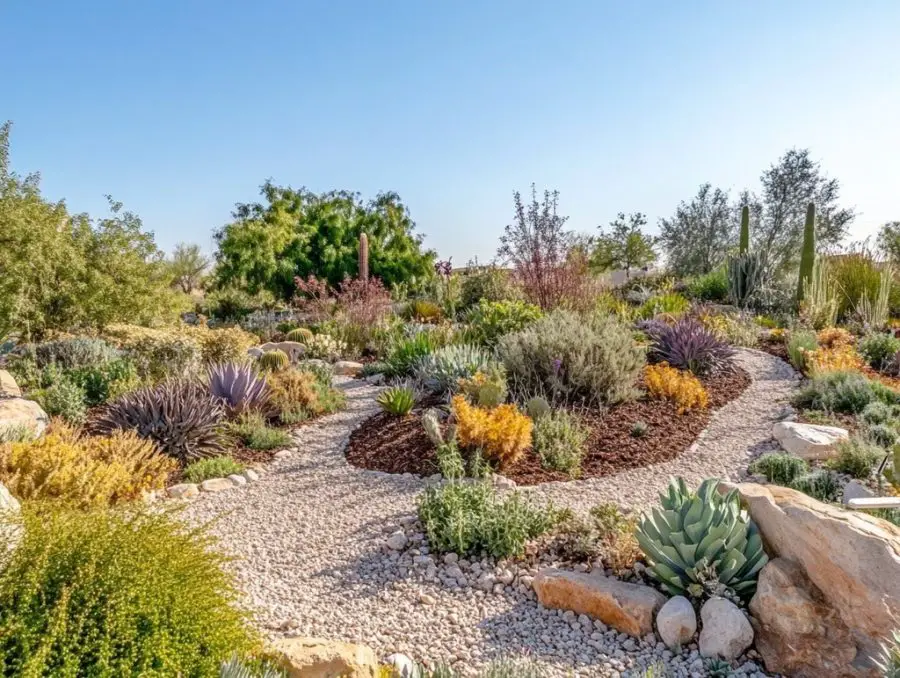
Using the 7 principles of xeriscaping and xeriscaping to conserve water isn’t just some gardening fad.
It’s a clever way to landscape that really focuses on water conservation and sustainability.
This method comes from arid regions, and it’s becoming more popular as folks look for environmentally friendly ways to make their outdoor spaces beautiful.
You’ll get to explore what xeriscaping is all about, where it came from, and all the benefits it brings, not just for the environment but also for your wallet.
Plus, you’ll learn about the seven essential principles that can turn your garden into a lush, water-efficient paradise.
Get ready to discover how you can create a stunning landscape while saving those precious resources!
What is Xeriscaping?
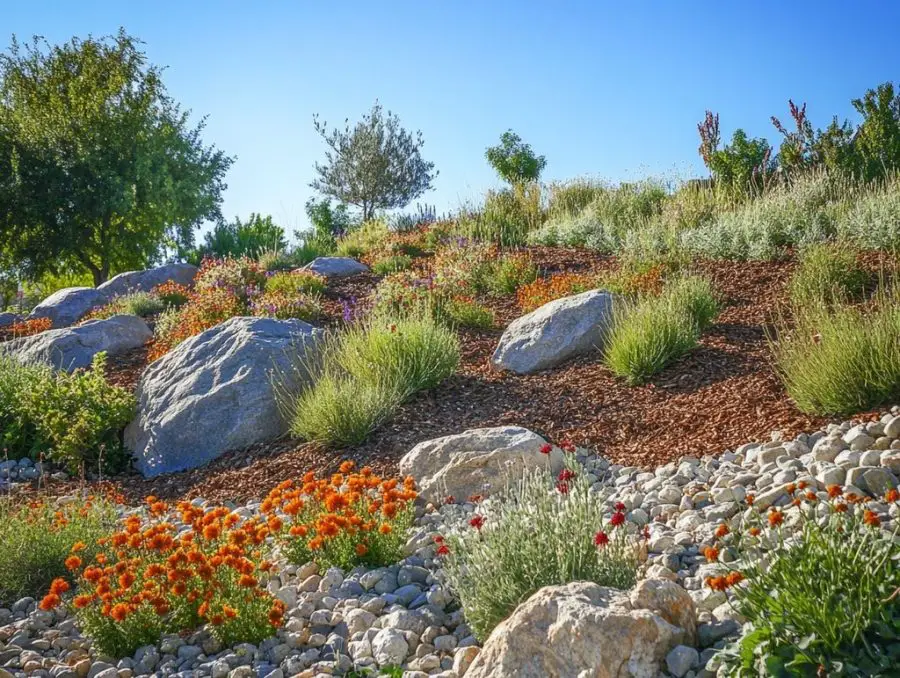
Xeriscaping is a sustainable landscaping approach that helps you minimize water use while keeping your garden looking great.
By choosing drought-resistant plants and using efficient watering techniques, xeriscaping promotes a more environmentally friendly way to garden.
What is xeriscaping? A beginner’s guide to drought-tolerant landscaping
This method has really taken off, especially in areas where water is scarce, as it creates beautiful outdoor spaces that thrive even in dry conditions.
Born out of the need to conserve water, xeriscaping combines principles like soil moisture conservation, improving soil quality, and increasing biodiversity to help you create a balanced ecosystem in your garden.
Definition and Origins
The term xeriscaping comes from the Greek word ‘xeros,’ which means dry, and it captures the essence of sustainable landscaping by focusing on native plants and smart watering practices.
This innovative gardening approach really took off in the late 20th century, primarily as a response to the increasing water scarcity in arid regions.
As communities began grappling with the challenges of climate change and shrinking water resources, it became crucial to develop landscaping methods that not only saved water but also boosted local biodiversity.
Embracing native plants was key in this transition since these species are naturally suited to the local environment, needing less maintenance and minimal irrigation.
Xeriscaping not only promotes sustainable practices but also encourages adaptation to climate changes, ultimately creating resilient ecosystems that can thrive even under environmental stress.
The Benefits of Xeriscaping
Xeriscaping brings a ton of benefits your way, covering both environmental and financial advantages, making it a fantastic choice for sustainable gardening practices.
By focusing on water conservation, xeriscaping helps you save on landscaping costs and even reduces the carbon footprint of maintaining your garden.
Plus, using drought-tolerant groundcovers and native plants boosts biodiversity and supports the ecosystem, creating a lively habitat for local wildlife.
It’s a win-win all around!
Environmental and Financial Advantages
The environmental benefits of xeriscaping are pretty impressive.
It helps promote ecological balance while cutting down on water usage and maintenance efforts—definitely a win-win.
This innovative landscaping approach not only gives you a beautiful outdoor space but also creates a thriving wildlife habitat, supporting various species that boost local biodiversity.
By choosing native and drought-resistant plants, you can set up a water-efficient landscape that needs minimal irrigation, which means your utility bills will thank you over time.
As more people embrace xeriscaping, everyone can make a real difference in regional water conservation efforts.
With less need for fertilizers and pesticides, you’re helping the environment.
And let’s not forget the lower maintenance costs, so xeriscaping is a savvy investment for both the planet and your wallet!
The 7 Principles of Xeriscaping
The 7 principles of xeriscaping are your go-to guidelines for crafting a sustainable landscape that can really thrive in dry conditions.
Plus, they help you minimize water use and reduce your environmental impact.
1. Xeriscape Planning and Design
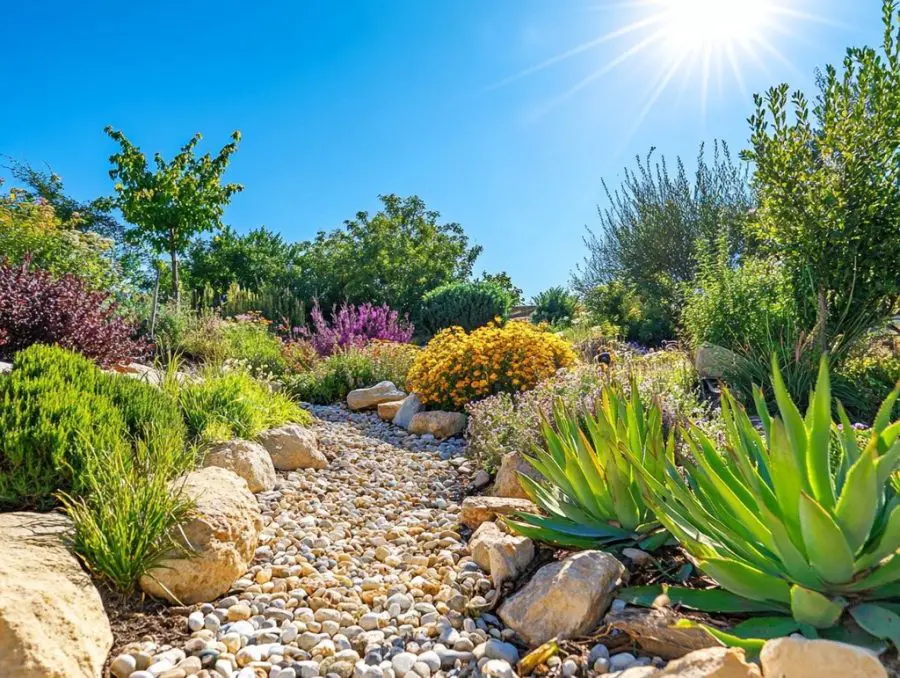
Planning and design are crucial first steps in your xeriscaping journey.
You want to make sure your garden beds are strategically placed to get the most out of your water use while also looking great.
By thoughtfully considering your layout, you can create a stunning landscape that’s both environmentally friendly and resource-efficient.
A successful xeriscape garden should also take seasonal planting into account, allowing for year-round interest and growth.
Getting to know the microclimates in your garden—those spots that might have different sunlight, moisture levels, or wind exposure, will help you choose plants that thrive in each specific condition.
This kind of careful design not only boosts your garden’s beauty but also benefits local ecosystems, encourages biodiversity, and cuts down on the need for chemical interventions.
In the end, you’re contributing to a more sustainable environment.
2. Soil Improvement
Soil improvement is key for your xeriscaping success because healthy soil helps retain moisture and supports drought-tolerant plants like a champ.
One great method to get there is to mix in organic soil amendments like compost or well-rotted manure.
These goodies can boost nutrient content and improve soil structure at the same time.
You might also want to consider erosion control techniques, like planting cover crops and putting in terraces.
These can help prevent soil loss and improve water infiltration.
Also, these sustainable practices protect your topsoil’s integrity and help keep moisture around by letting water soak in deeper and reducing evaporation.
By focusing on these strategies, you can create a thriving environment for your plants while using resources wisely.
3. Appropriate Plant Selection
Choosing the right plants is key when you’re diving into xeriscaping.
Picking native and drought-resistant plants means your landscape can thrive with minimal watering.
This smart approach not only saves water but also boosts plant diversity, which helps make the ecosystem more resilient.
By using local plants, you can create a sustainable environment that supports xerophytic species, perfectly suited for dry conditions.
These choices lead to a vibrant landscape that needs less maintenance and irrigation while providing a home for local wildlife.
In short, embracing a mix of drought-resistant plants not only beautifies your outdoor space but is also a crucial step toward environmental conservation.
It’s a savvy move for anyone looking to be eco-friendly in their landscaping efforts.
4. Efficient Irrigation
Efficient irrigation practices are crucial in xeriscaping because they help you manage water wisely while keeping waste to a minimum, ensuring your plants get the moisture they need.
When you use systems like drip irrigation, you can send water straight to the roots of your plants, which cuts down on evaporation and runoff.
This method not only saves water but also helps your plants thrive by providing consistent moisture levels.
You might also want to consider incorporating rainwater harvesting systems to boost your water efficiency.
By collecting and storing rainwater, you can tap into a natural and sustainable resource for irrigation, especially during those dry spells.
Don’t forget about seasonal maintenance, either!
Adjusting your watering schedules based on rainfall and your plants’ needs is key to optimizing these irrigation strategies, making xeriscaping not only effective but also eco-friendly.
5. Mulching
Mulching is a game-changer in xeriscaping. It helps you retain moisture, improve soil health, and prevent erosion in your garden beds.
By covering the soil with different organic or inorganic materials, you can really boost your landscape’s resilience against drought and nutrient depletion.
If you go for organic options like straw, wood chips, or shredded leaves, you’ll not only conserve moisture but also gradually enhance the soil structure as they break down.
On the flip side, if you choose inorganic materials like gravel or landscape fabric, you get durability and effective erosion control, which helps reduce runoff during heavy rainstorms.
With these strategies, mulching becomes essential for promoting garden sustainability and building a healthier ecosystem, making it an invaluable practice for anyone who loves gardening.
6. Xeriscape Maintenance
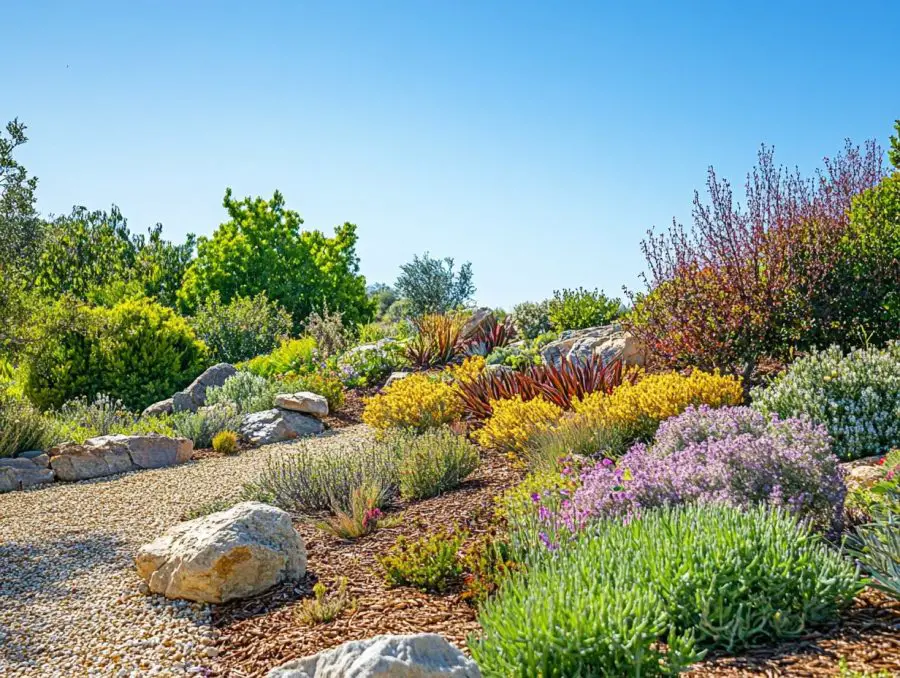
Regular maintenance is the secret sauce to keeping your xeriscape garden thriving and beautiful over time.
To make sure everything stays healthy and looks great, you’ll want to incorporate some seasonal maintenance practices.
This means checking your irrigation system, tweaking those mulch layers, and giving the soil a little boost with amendments to enhance nutrient availability.
Weed management is another key player. By regularly pulling out those pesky unwanted plants, you can prevent them from hogging resources, which supports the vibrant landscape you’re going for with xeriscaping.
These simple gardening tips not only help your plants thrive but also boost biodiversity, creating a lively ecosystem that attracts all sorts of wildlife while keeping water usage to a minimum.
7. Water Conservation
Water conservation is at the core of xeriscaping, shaping every bit of your garden design and maintenance to make sure you’re practicing sustainability and keeping your environmental impact low.
Try to eliminate lawns and replace turfgrass with more water-friendly natural grasses or groundcovers.
By focusing on methods that boost moisture retention and smart irrigation management, you can create beautiful landscapes that thrive on limited water resources.
Using native plants that are adapted to your local climate can really cut down on how much additional watering you’ll need to do.
Adding mulch to your garden beds not only keeps the soil moist but also fights off pesky weeds, which means less competition for water.
Using efficient irrigation techniques like drip systems and rainwater harvesting lets you target your watering, ensuring that each plant gets just the right amount of moisture without wasting any.
All these practices work together to create a healthier ecosystem and promote responsible water use.
The 7 Principles of Xeriscaping FAQs
What are the 7 principles of Xeriscaping?
The 7 principles of Xeriscaping are planning and design, soil improvement, practical turf areas, efficient irrigation, use of native plants, mulching, and appropriate maintenance.
Why is planning and design important in Xeriscaping?
Planning and design is important in Xeriscaping because it helps create a water-efficient landscape that is adapted to the local climate and conditions.
How does soil improvement play a role in Xeriscaping?
Soil improvement is crucial in Xeriscaping because it helps create a healthy and sustainable environment for plant growth, reducing the need for excessive watering and fertilizing.
What is the purpose of practical turf areas in Xeriscaping?
The purpose of practical turf areas in Xeriscaping is to use grass only where it is necessary for functional or recreational purposes, reducing water and maintenance needs.
Why is efficient irrigation an important principle in Xeriscaping?
Efficient irrigation is important in Xeriscaping to minimize water waste and promote sustainable water use in landscaping.
How does the use of native plants benefit Xeriscaping?
The use of native plants in Xeriscaping is beneficial because they are adapted to the local climate and require less water and maintenance compared to non-native plants.
What are the key aspects of appropriate maintenance in Xeriscaping?
The key aspects of appropriate maintenance in Xeriscaping include proper pruning, timely watering, and regular mulching to retain moisture and prevent weed growth.
Xeriscape Gardens Archives – Urban Gardening Ideas
Related Content
Visit my Amazon Influencer Page for videos and gardening products Grow Your Own Garden


